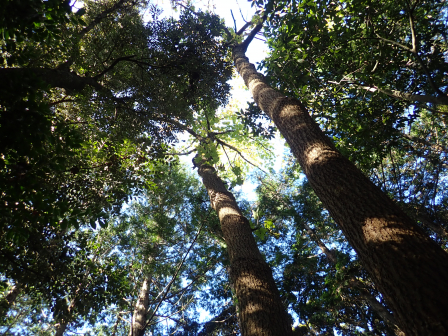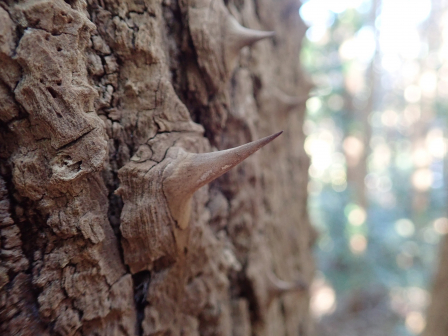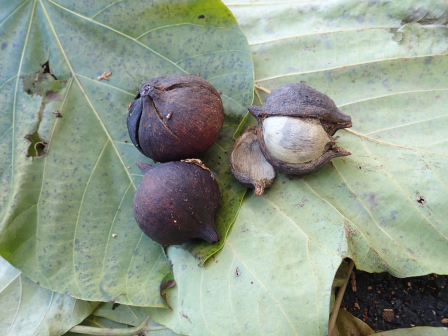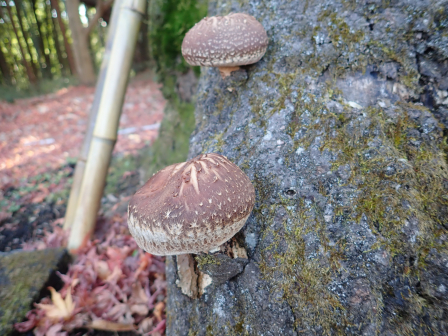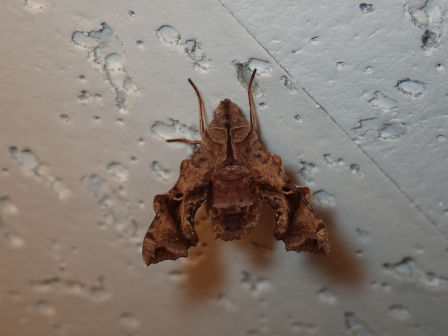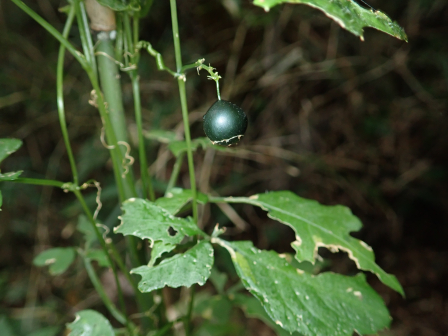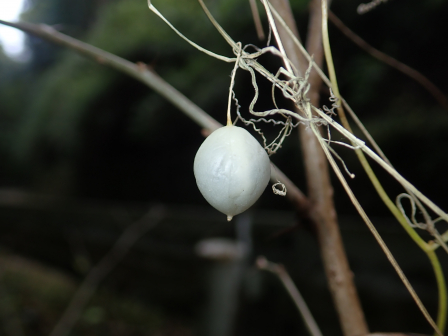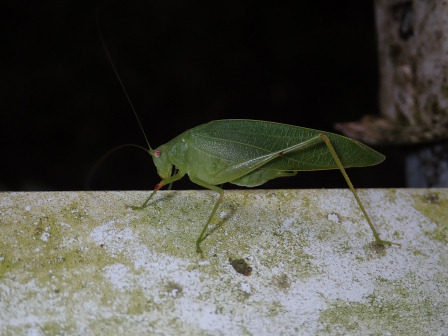フィールド日記
2021年12月
2021.12.31
ハリギリ
聖心坂の途中の森に大きなハリギリの木があります。別名センノキとも呼ばれ、木材として使われてきました。きれいな木目で、ヨーロッパでも人気だそうです。
和名の通り、若い木の幹にはトゲが見られます。
The tall trees called "Hari-Giri" grow in a forest near the "Seishin Zaka(聖心坂)". They are called "Caster aralia" in English and are used as quality wood. The wood-grain is beautiful and the wood is popular in Europe. As the name means thorns, the young trees have thorns on their stems.
2021.12.28
オオアブラギリ
聖心坂にオオアブラギリの果実が落ちていました。和名は、種子から良質の乾性油がとれることに由来します。中国原産で、亜熱帯地域で広く栽培されています。日本でも各地で栽培されていたものが逸出し、野生化しています。
I found the fruit of "Oo-Abura-Giri (オオアブラギリ)" on the "Seishin Zaka(聖心坂)". The name comes from the fact that good drying oil is produced from their seeds. They come from China and are widely cultivated over the subtropical regions. In Japan, some of the cultivated ones have spread and they now grow wild.
2021.12.24
ニシキオニグモ
図書館の渡り廊下で、ニシキオニグモを見つけました。大きさはメスで12~18㎜ほどある大型のクモで、山地の神社や寺院でよく見られます。腹部には複雑な美しい模様があります。静岡県では準絶滅危惧種に指定されています。
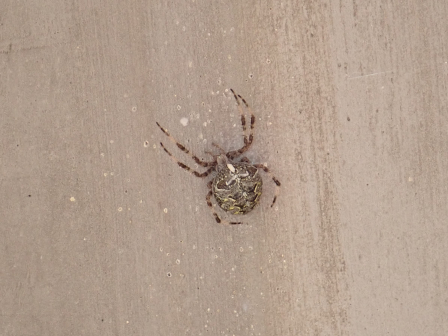
I found a spider called "Nishiki-Onigumo (ニシキオニグモ)" on the corridor to the library. They are a large spider. The female ones are from 12mm to 18mm in length. They are often seen in shrines and temples on mountains. They have beautiful patterns on their abdomen. They are designated as near-threatened species in Shizuoka prefecture.
2021.12.21
シイタケ
共生の森で、高校1年生が植菌したシイタケが発生していました。シイタケは春と秋に発生します。ほだ木として用いられている木はクヌギで、里山の代表的な樹種です。
"Shiitake (シイタケ)" mushrooms that 10th grade students planted are growing in the Kyoseinomori-Forest (共生の森). "Shiitake" mushrooms grow in spring and fall. The wood used as bed log is the "Kunugi (クヌギ)" tree, which is a typical tree in "Satoyama (里山)".
2021.12.17
ホシヒメホウジャク
天井にホシヒメホウジャクが止まっていました。スズメガのなかまとしては小型で、35mm~40mmほどです。また、後翅の縁にこぶ状の突起があり、翅が波打っているように見えるのも特徴です。成虫で越冬することもあります。
I found a "Hoshi-Hime-Houjaku (ホシヒメホウジャク)" on the ceiling. Despite of a moth that belongs to a group of "hawk moth", they are small and 35 mm to 40 mm in length. They are characterized by the rear wings that have protrusions looking like a wave. Some of them stay over the winter as adults.
2021.12.14
アマチャヅル
裏道でアマチャヅルの果実を見つけました。萼や花弁の名残と思われる環状の模様があるのが特徴です。和名は葉に甘味があり、本種からつくったお茶の味が、アジサイの仲間のアマチャからつくったお茶に似ることが由来と言われています。(アマチャヅルの花のようすはこちら)
I found the fruit of "Amacha-Zuru (アマチャヅル)" on the back road. The fruit is characterized by the ring pattern on it, which is the remain of its calyx and petal. The name comes from the fact that their leaves are sweet and the tea made of their leaves tastes like the tea made of those of "Amacha (アマチャ)" plant, which belongs to the group of Hydrangea.
2021.12.10
スズメウリ
裏道でスズメウリの果実を見つけました。果実は1cmほどの球形で、はじめは緑色ですが、後に写真のように灰白色になります。和名のスズメウリは、カラスウリに対してより小型であることが由来のようです。
I found the fruit of "Suzume-Uri (スズメウリ)" plants on the back road. Their fruit is around 1 cm in diameter. They are green at first and turn ash-white later as you can see in the photo. The name "Suzume-Uri" means "sparrow-melon" and it comes from the fact that their fruit is smaller than the fruit of "Karasu-Uri (カラスウリ)" plants, whose name means "crow melon".
2021.12.07
ナンテン
ナンテンの実が赤く色づいています。関東以西に自生していますが、かつて中国から渡来した栽培品が逸出したものとも言われています。和名のナンテンが「難転、難を転ずる」に通ずることから縁起が良い木とされ、公園や庭木としてしばしば植栽されています。
The fruit of "Nanten (ナンテン)" trees has turned red. They live in the west of Kanto region, however, it's said that they derived from the cultivated trees that came from China in the past. The sound of their name can mean "turning difficulty into fortune" so they are regarded as a lucky tree. They are often planted in parks and gardens.
2021.12.03
ヒメクダマキモドキ
裏道でヒメクダマキモドキを見つけました。本州では海に近い温暖な地域の林縁などでよく見られる種で、最近では都市部の公園でも見ることが多いようです。特にアカメガシワを好んで食べるようです。
I found a "Hime-Kudamaki-Modoki (ヒメクダマキモドキ)" cricket on the back road. In the main island of Japan, they are often seen on the edge of forests in warm regions near the sea. It's said that they are seen even in parks in the city these days. They like to eat leaves of "Akame-Gashiwa (アカメガシワ)" trees.
- 1 / 1


